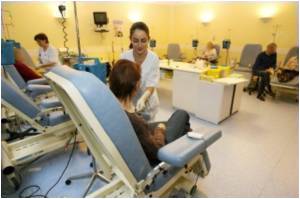Chemotherapy may increase a patient's risk of developing therapy-related acute myeloid leukemia, a rare but frequently fatal condition.

"In the course of improving interventions and survival rates in many types of cancer, we have learned that certain chemotherapies can cause damage to cells in the bone marrow, increasing a patient's risk of leukemia. However, no recent large-scale studies have evaluated how the risk of treatment-related leukemia has evolved with the changing treatment strategies," said Lindsay Morton, PhD, of the National Cancer Institute (NCI) and lead author of the study.
To examine how the risk of tAML has evolved over time among cancer patients treated with chemotherapy, Dr. Morton and a team of researchers at the NCI's Division of Cancer Epidemiology and Genetics evaluated data from cancer registries in the U.S. Surveillance, Epidemiology, and End Results (SEER) Program, identifying adult patients ages 20-84 who were diagnosed with cancer (any type) between 1975 and 2008 and who were treated with chemotherapy. SEER data files were reviewed to determine tAML risk based on first type of cancer, time since diagnosis, age at diagnosis, and year of diagnosis.
Among the 426,068 patients whose data were eligible for analysis, Dr. Morton's team confirmed 801cases of tAML, nearly five times more than the number of cases expected in the general population. To help explain the changes in relative risk over time, investigators compared the trends in the data with evolving treatment recommendations and major therapeutic discoveries as described in the medical literature. While patient information in the SEER database did not include data on specific drugs or doses, the incidence trends were consistent with changing treatment practices and the toxicities associated with certain chemotherapies. Notably, the proportion of patients receiving chemotherapy, both with or without radiotherapy, increased during the study period for many malignancies.
As the team compared tAML risks with trends in cancer treatment over time, they analyzed several factors that likely contributed to the differences in risk between patients, including the type of cancer initially diagnosed and the year of diagnosis. For example, trends in risk for breast cancer patients (which comprised roughly one-third of tAML cases in the study) correlated to changes in breast cancer treatment protocols over the last several decades, suggesting that the decrease in tAML risk observed among breast cancer survivors in the 1980s might be attributable to an increased use of cyclophosphamide-based chemotherapy, which is less likely to cause leukemia than earlier treatment options.
A similar decline in risk was observed among ovarian cancer patients, possibly linked to a shift in ovarian cancer chemotherapy treatment in the 1970s from melphalan, a type of chemotherapy that has been shown to trigger leukemia, to a less toxic platinum-based chemotherapy. In contrast, tAML risks increased over the last several decades among patients treated with chemotherapy for non-Hodgkin lymphoma (NHL), possibly as a result of improvements in survival for patients who received multiple courses of treatment.
Advertisement
The database analysis also found that relative tAML risk for many patients tended to decline with increasing time since initial cancer diagnosis. For those with non-hematologic malignancies, there was no evidence of elevated tAML risks more than 10 years following diagnosis, whereas risks persisted more than 10 years after diagnosis for patients with Hodgkin lymphoma (HL), NHL, and myeloma. Heightened tAML risk among these patients could be linked to the higher intensity and longer duration of their treatment.
Advertisement
Source-Eurekalert














